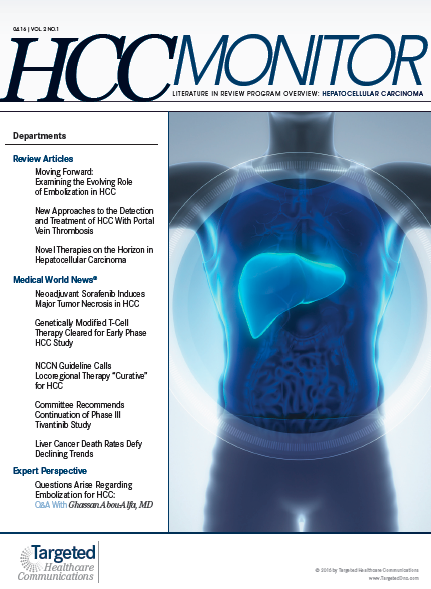NCCN Guideline Calls Locoregional Therapy "Curative" for HCC
Ablation is now considered a potentially curable treatment option for patients with hepatocellular carcinoma (HCC) that should be considered secondarily to transplant and resection.
The updated recommendation for locoregional therapy was based on a meta-analysis of randomized controlled trials comparing radiofrequency ablation with surgical resection for patients with HCC that was <3 cm in size. In the study, the 1-, 3-, and 4-year survival rates were similar between the treatment modalities, said Anne Covey, MD, who presented the guideline at the meeting.
“The guidelines have most recently changed to include ablation as a potentially curative option,” Covey, attending radiologist at Memorial Sloan Kettering Cancer Center, said in an interview withTargeted Oncology.“It used to be that the only curative therapies were surgery or transplant, now patients can have locoregional therapy as a potential cure, and that is big.”
Ablation has the advantage of requiring fewer transfusions and a shorter hospital stay compared with resection, but it is limited by tumor location. Since the rate of local recurrence is higher with ablation, the guideline recommended that surgery and transplantation should be considered first. For ablation to be considered, hepatic tumors should be in a location accessible for percutaneous, laparoscopic, or open approaches. “Tumors near critical structures are not amenable to ablation,” Covey said.
Arterially directed therapies are generally recommended for patients who have unresectable tumors, due to inadequate hepatic reserve, tumor location, patient comorbidities, or a performance status that makes resection riskier, said Covey. Tumors may be amenable to arterially directed therapy if the arterial blood supply to the tumor may be isolated without excessive non-target treatment.
Examples of arterially directed therapies are bland embolization, transarterial chemoembolization (TACE), embolization with drug-eluting beads, and “radio” embolization with Yttrium-90. The choice of arterially directed therapy should be based on local expertise, Covey said.
“One of things we’re working on, and that the guidelines will soon encompass, is imaging for locoregional therapies,” she said. “If we have principles of imaging as part of the hepatocellular guidelines that will be very helpful in guiding people into the modalities that they should use.”
For tumors 3 to 5 cm, the guideline recommends the addition of arterially directed therapy to ablation. “By doing the embolization, we may treat micrometastases or tumor around the lesion we don’t treat effectively with ablation alone,” she said. Additionally, unresectable or inoperable lesions >5 cm should be considered for treatment using arterially directed therapy or systemic therapy, according to the guideline.
Relatively new to the NCCN guideline is the inclusion of locoregional therapy for the treatment of patients with portal vein thrombus (PVT), which used to be a contraindication for locoregional therapy. The hepatic portal vein is critical to normal liver function and supplies approximately 75% of the blood supply to the liver. In general, an estimated 10% to 40% of patients with HCC will present with PVT at the time of diagnosis.
“The locoregional panel has also expanded to patient with minimal extrahepatic disease and patients who have portal vein thrombus, a tumor in the portal vein,” said Covey. “It’s really increasing the patients who are candidates for this type of potentially lifesaving treatment.”
Other Locoregional Options
Other types of locoregional therapies were described in the guideline, including external beam radiation therapy (EBRT), stereotactic body radiotherapy (SABR), and embolization with sorafenib (Nexavar). In the case of sorafenib, this option looked promising early on, but did not seem to add benefit when added to complete ablation, according to Daniel T. Chang, MD, who also presented the new guidelines. The current recommendation is to reserve sorafenib for residual or recurrent tumors that are not amenable to additional local therapy.
EBRT (conformal or stereotactic) is a category 2B locoregional treatment recommendation for HCC inoperable hepatic tumors. Radiation can treat multiple tumors and the dose can be adjusted based on tumor size and the location of critical structures, said Chang, associate professor of radiation oncology, Stanford University.

Gasparetto Explains Rationale for Quadruplet Front Line in Transplant-Ineligible Myeloma
February 22nd 2025In a Community Case Forum in partnership with the North Carolina Oncology Association, Cristina Gasparetto, MD, discussed the CEPHEUS, IMROZ, and BENEFIT trials of treatment for transplant-ineligible newly diagnosed multiple myeloma.
Read More